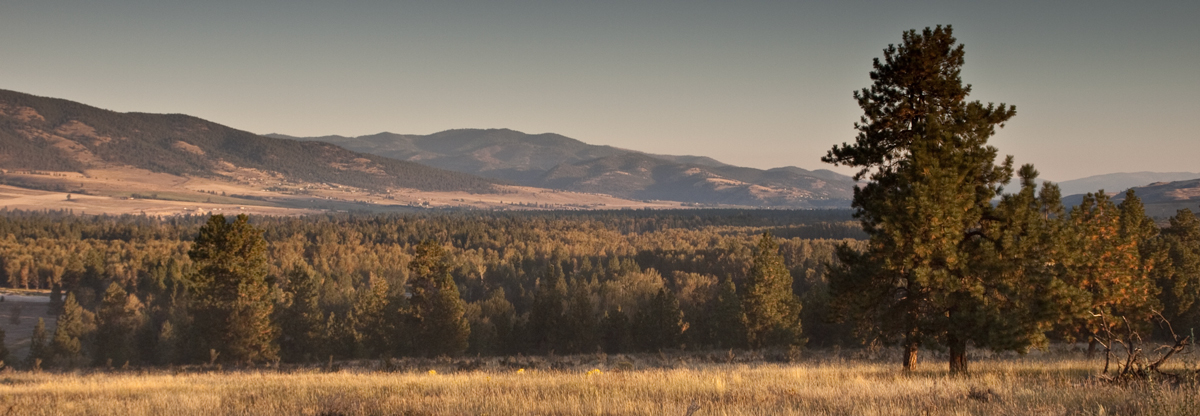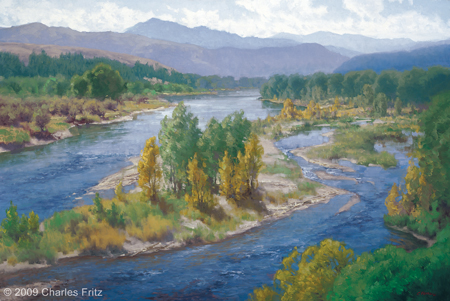Travelers’ Rest, MT The expedition continues its northern route up the Bitterroot River reaching Travelers’ Rest, a well-used camping area on present-day Lolo Creek. Their Indian guide, Toby, tells them of a good pass leading to the Missouri River, and Spanish officials devise another plan to stop the expedition.
Arrival at Travelers’ Rest[1]Originally aired weekdays by Yellowstone Public Radio during the Bicentennial observance of 2003-2006. Narrated by Hal Hansen. Scripts by Whit Hansen and Ed Jacobson. Produced by Leni Holliman. © … Continue reading
Sunlight Reaches the Bitterroot Valley
© 11 September 2009 by Kristopher K. Townsend. Permission to use granted under the Creative Commons Attribution-Share Alike 4.0 International license.
Above: View north. The Travelers’ Rest area is in the distance with Lolo Creek (Montana) and the Lolo Trail coming from the west below the distant ridge.
Wide Valley
proceeded down the Flathead river leaving it on our left, the country in the valley of this river is generally a prarie and from five to 6 miles wide the growth is almost altogether pine principally of the longleafed kind, with some spruce and a kind of furr resembleing the scotch furr.
—Meriwether Lewis
“Clark’s River Near Travelers’ Rest”
36″ x 54″ oil on board
© 2009 by Charles Fritz. Used by permission.
River Crossings
this creek [Bitterroot River] has got to be a Small handsome River and gentle current we have to wade it often and find it as deep as the horses belleys.
—John Ordway
Another Road to the Buffalo
our guide [Toby] . . . informed us that it continues it’s course along the mountains to the N. as far as he knew it and that not very distant from where we then were it formed a junction with a stream nearly as large as itself which took it’s rise in the mountains near the Missouri to the East of us and passed through an extensive valley generally open prarie which forms an excellent pass to the Missouri.
—Meriwether Lewis
Reaching Travelers’ Rest
encamped on a large creek which falls in on the West as our guide informes that we should leave the river at this place . . . . we called this Creek Travellers rest. it is about 20 yards wide a fine bould clear runing stream
—Meriwether Lewis
Celestial Observations
At our encampment of this evening observed time and distance of the Moon’s western limb from α Aquila
West with Sextant.
—Meriwether Lewis
Weather Diary
Weather at rise
Wind at rise
Weather at 4 P.M. Wind at 4 P.M. cloudy after rain N E cloudy after rain N E arrived a[t] travelers rest Creek
—Meriwether Lewis[2]To assist the reader, the editor of this web page has omitted the date column and spelled out some abbreviations.
Spanish Opposition
The former Spanish governor of Louisiana encourages the New Mexico governor, Joaquin del Real Alencaster, to convince the Pawnees to stop the expedition and confiscate their possessions when they return down the Missouri River.
Chihuagua, September 9, 1805
. . . when the expedition of Captain Merri returns . . . they [the Pawnees] would intercept it, taking its Members into custody, which would be difficult [for us?] to accomplish; you will be able to persuade them at the least, under the promise of the recompense they desire, to do everything possible to take away whatever Coffers and papers the said expedition may be carrying . . . .
—Nemesio Salcedo[3]Salcedo to Alencaster in Donald Jackson, The Journals of Zebulon Montgomery Pike (Norman, Oklahoma: University of Oklahoma Press, 1966), 2:105.
Travelers’ Rest is a High Potential Historic Site along the Lewis and Clark National Historic Trail managed by the U.S. National Park Service. The site, managed by the Travelers’ Rest Preservation & Heritage Association, is a Montana State Park with interpretive trail and a visitor center.
Notes
| ↑1 | Originally aired weekdays by Yellowstone Public Radio during the Bicentennial observance of 2003-2006. Narrated by Hal Hansen. Scripts by Whit Hansen and Ed Jacobson. Produced by Leni Holliman. © 2003 by Yellowstone Public Radio. |
|---|---|
| ↑2 | To assist the reader, the editor of this web page has omitted the date column and spelled out some abbreviations. |
| ↑3 | Salcedo to Alencaster in Donald Jackson, The Journals of Zebulon Montgomery Pike (Norman, Oklahoma: University of Oklahoma Press, 1966), 2:105. |




